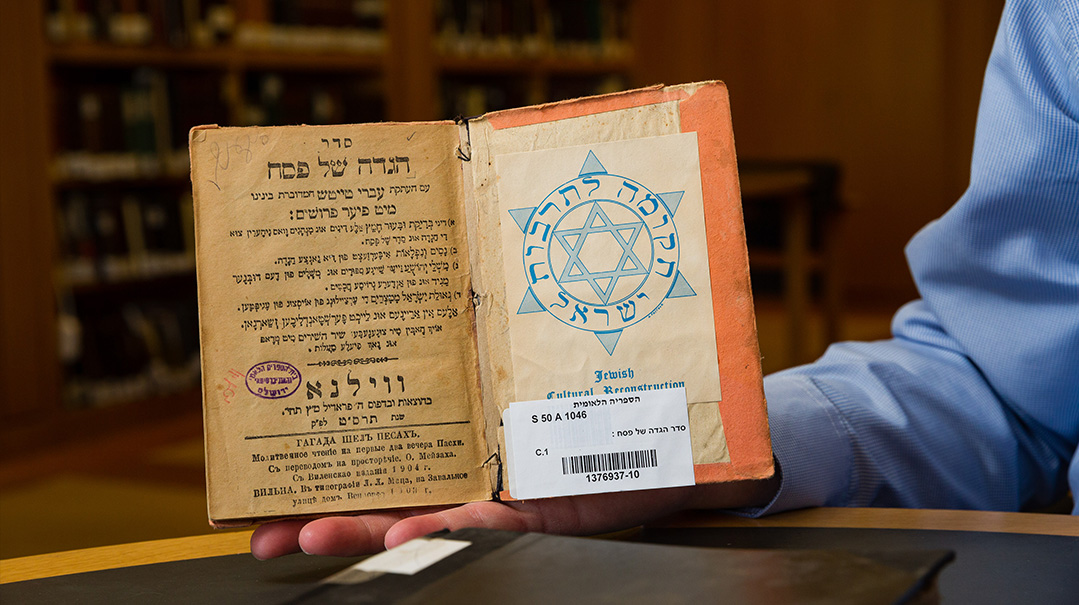Snatched from the Eagle’s Claws
| April 11, 2022How the Third Reich preserved a treasury of Jewish books

Photos: Elchanan Kotler
W
hen Rabbi Nachum Zitter, studying in the library science track of an Information Technology master’s degree program at Bar-Ilan University, told his family that he’d been assigned to keep a daily library blog, their reactions ranged from disbelief to shouts of laughter.
“What will you write about every day?” they asked him. “Monday, someone talked in the Reading Room, and I told him to be quiet. Tuesday someone talked in the Reading Room and I told him to be quiet. Wednesday…”
You get the idea. Keep a library blog? What can you say about libraries, stuffy places where there’s really nothing to get excited about except the occasional reader speaking in a loud voice who needs to be shushed?
Full disclosure here: Nachum is my son, my bechor. Fuller disclosure: I was one of those who laughed at the idea of a library blog.
One final disclosure, and a confession: Boy, was I ever wrong.
Turns out the National Library of Israel, where Nachum is now Head of Reference Services, is a fascinating place, teeming with complex characters and compelling stories both inside and outside of the covers of the books.
Here is the story of how one librarian, Daniel Lipson, found a piece of his family’s story in an old notebook, a find that led him to discover a treasure trove from our people’s tragic history.
Here is the story of books destroyed, books saved, books returned and reclaimed.
Here is the story of a collection known as Otzrot haGolah — the Treasures of the Diaspora.
And it all happened in the library…

Nothing by Chance
Librarians are trained to do intensive research into whatever topic they’re looking into — but they also know that sometimes you can bump into something interesting, seemingly by chance.
“Serendipity, finding something valuable that you haven’t been specifically looking for, is one of my favorite words,” says Daniel Lipson, reference librarian at the National Library.
Lipson, a young father of seven living in Ramat Beit Shemesh, uses the word serendipity to describe his initial find, one that led him to years of research into Otzrot haGolah. Lipson was simply looking through an archive of pinkasei mohalim — registers of bris milahs kept by mohalim in pre-Holocaust Europe. The National Library owns hundreds of such notebooks. Suddenly, he was shocked to find a pinkas kept by his great-great-great-great-grandfather, Rabbi Yoseph Hackenbroch from Deutz, Germany, recording brissim from 1804 to 1831.
“I was especially moved to see that my great-great-great-great-grandfather included a record of the bris he gave his own son, Eliezer, since my son, Yonatan Eliezer, shares that family name,” Lipson told me.
Lipson’s find was serendipitous (or, we might say, it was simply bashert). But after that first lucky find, he was inspired to do more research, and that’s when his family’s history led him to the larger story of his people.
Provenance is another word librarians enjoy using. It means a record of where something came from — where it originated, and how and when it was finally acquired, be it a work of art, a piece of antique furniture, or, most often in libraries, a manuscript or a book.
Lipson wondered how, when, and from where the National Library had gotten hold of his family heirloom. He asked a colleague in the Manuscripts Department, who told him that its library provenance was Offenbach 1946.
Offenbach 1946. It was an answer that opened up many other questions. How had a pinkas mohalim written in Deutz ended up in a city just outside Frankfurt? How had the pinkas survived the Holocaust? And how had it made its way from a Europe devastated by a world war to Israel’s National Library?
Lipson turned to some of the older librarians with his questions. And that’s where he first heard the words Otzrot haGolah, literally, the Treasures of the Diaspora. Ironically, these books — sifrei kodesh, community records, children’s books, science texts, works written in Hebrew, Yiddish, Ladino, and European languages, had been saved from destruction during the Holocaust… by the Nazis themselves.
Oops! We could not locate your form.







